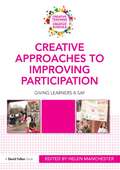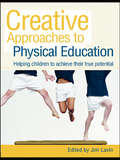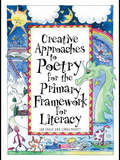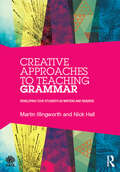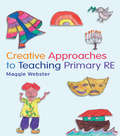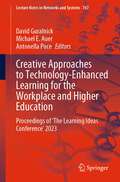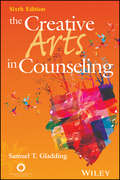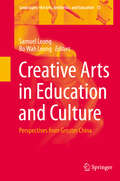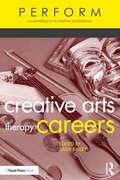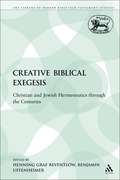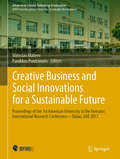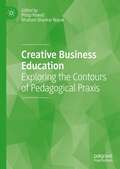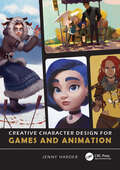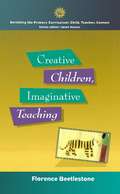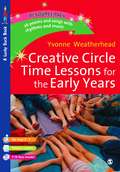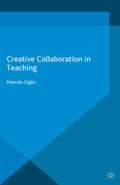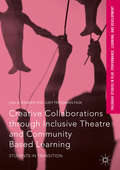- Table View
- List View
Creative Approaches to Improving Participation: Giving learners a say (Creative Teaching/Creative Schools)
by Helen ManchesterIntroducing creativity to the classroom is a concern for teachers, governments and future employers around the world, and there has been a drive to make experiences at school more exciting, relevant, challenging and dynamic for all young people, ensuring they leave education able to contribute to the global creative economy. Creative Approaches to Improving Participation examines ways in which young people have been given a creative voice in the classroom, and have actively participated in their own learning, transforming classrooms, curricula, assessment structures and teaching practices. Promoting reflection on current ‘student-teacher-school’ relationships, the contributions within this book illustrate how the active engagement of students can lead to greater motivation, self-reliance and risk-taking, skills essential for a successful post-school career. Through an exploration of students’ current inclusion in school life, this book provides: a study of key issues and debates surrounding student participation ideas for increasing student participation and ‘personalised learning' case studies from a range of creative learning projects with analysis of their achievements guidance on the creation of active pedagogies practical suggestions for reflective practice. A practical, accessible guide to creatively increasing students’ participation, this book is valuable reading for all practising and trainee teachers, school managers and school leaders working with young people in education.
Creative Approaches to Improving Participation: Giving learners a say (Creative Teaching/Creative Schools)
by Helen ManchesterIntroducing creativity to the classroom is a concern for teachers, governments and future employers around the world, and there has been a drive to make experiences at school more exciting, relevant, challenging and dynamic for all young people, ensuring they leave education able to contribute to the global creative economy. Creative Approaches to Improving Participation examines ways in which young people have been given a creative voice in the classroom, and have actively participated in their own learning, transforming classrooms, curricula, assessment structures and teaching practices. Promoting reflection on current ‘student-teacher-school’ relationships, the contributions within this book illustrate how the active engagement of students can lead to greater motivation, self-reliance and risk-taking, skills essential for a successful post-school career. Through an exploration of students’ current inclusion in school life, this book provides: a study of key issues and debates surrounding student participation ideas for increasing student participation and ‘personalised learning' case studies from a range of creative learning projects with analysis of their achievements guidance on the creation of active pedagogies practical suggestions for reflective practice. A practical, accessible guide to creatively increasing students’ participation, this book is valuable reading for all practising and trainee teachers, school managers and school leaders working with young people in education.
Creative Approaches to Physical Education: Helping Children to Achieve their True Potential
by Jim LavinCreative Approaches to Physical Education provides guidance on how to develop innovative new approaches to the delivery of each area of the National Curriculum for PE at Key Stages 2 and 3. The ideas have all been successfully developed in schools where every child has been encouraged to find success and to express themselves in new ways that surprise and delight teachers. Pupils feel ownership of their learning and pride in their achievements, fostering interest, creativity and motivation. Ideal for non-specialist and specialist PE teachers and trainee teachers alike, this book: explores the PE curriculum in a much wider sense than traditional approaches allow covers the key areas of physical education such as games, dance and gymnastics inspires us to look afresh at how we can exploit the learning potential of the outdoors shows how children use skills to express themselves creatively gives innovative suggestions for the use of ICT in PE teaching to encourage independent, personalised leaning examines how physical education can be linked with other subjects in a creative way. Childhood obesity is a growing concern and there are worries that young people have few purposeful leisure interests. This book offers teachers and all those who work with young people alternative approaches and activities that allow young people to express their creative side through physical activity and discover active healthy interests that will last a lifetime.
Creative Approaches to Physical Education: Helping Children to Achieve their True Potential
by Jim LavinCreative Approaches to Physical Education provides guidance on how to develop innovative new approaches to the delivery of each area of the National Curriculum for PE at Key Stages 2 and 3. The ideas have all been successfully developed in schools where every child has been encouraged to find success and to express themselves in new ways that surprise and delight teachers. Pupils feel ownership of their learning and pride in their achievements, fostering interest, creativity and motivation. Ideal for non-specialist and specialist PE teachers and trainee teachers alike, this book: explores the PE curriculum in a much wider sense than traditional approaches allow covers the key areas of physical education such as games, dance and gymnastics inspires us to look afresh at how we can exploit the learning potential of the outdoors shows how children use skills to express themselves creatively gives innovative suggestions for the use of ICT in PE teaching to encourage independent, personalised leaning examines how physical education can be linked with other subjects in a creative way. Childhood obesity is a growing concern and there are worries that young people have few purposeful leisure interests. This book offers teachers and all those who work with young people alternative approaches and activities that allow young people to express their creative side through physical activity and discover active healthy interests that will last a lifetime.
Creative Approaches to Poetry for the Primary Framework for Literacy
by Jan Foale Linda PagettCreative Approaches to Poetry for the Primary Framework for Literacy supports teachers in planning, teaching and, most importantly, enjoying poetry with their pupils. With an emphasis on creative, cross curricular approaches the authors explore tried and tested methods of teaching poetry in an engaging and comprehensive manner. A carefully considered range of poems has been included in order to expand children’s repertoires in a variety of poetic forms. Chapters cover: how to develop a range of creative approaches to teaching poetry, involving visualisation, drama, choral speaking, performance, discussion and writing how to engage children from a variety of backgrounds and abilities in experiencing poetry in its many forms integrating the teaching of poetry with all other areas of the curriculum including ICT and citizenship effectively linking all work to the KS1 poetry units of the renewed Primary National Framework for Literacy an innovative model that takes children on a journey beginning before they meet the poem through to becoming poets themselves. This accessible and user-friendly book includes informative case studies, photographs and children’s work to demonstrate alternative routes to working with poetry. It will prove an invaluable resource for all primary teachers seeking to employ progressive and effective strategies in the teaching of poetry.
Creative Approaches to Poetry for the Primary Framework for Literacy
by Jan Foale Linda PagettCreative Approaches to Poetry for the Primary Framework for Literacy supports teachers in planning, teaching and, most importantly, enjoying poetry with their pupils. With an emphasis on creative, cross curricular approaches the authors explore tried and tested methods of teaching poetry in an engaging and comprehensive manner. A carefully considered range of poems has been included in order to expand children’s repertoires in a variety of poetic forms. Chapters cover: how to develop a range of creative approaches to teaching poetry, involving visualisation, drama, choral speaking, performance, discussion and writing how to engage children from a variety of backgrounds and abilities in experiencing poetry in its many forms integrating the teaching of poetry with all other areas of the curriculum including ICT and citizenship effectively linking all work to the KS1 poetry units of the renewed Primary National Framework for Literacy an innovative model that takes children on a journey beginning before they meet the poem through to becoming poets themselves. This accessible and user-friendly book includes informative case studies, photographs and children’s work to demonstrate alternative routes to working with poetry. It will prove an invaluable resource for all primary teachers seeking to employ progressive and effective strategies in the teaching of poetry.
Creative Approaches to Teaching Grammar: Developing your students as writers and readers (National Association for the Teaching of English (NATE))
by Nick Hall Martin IllingworthCreative Approaches to Teaching Grammar is an easily accessible, practical guide full of ideas to support teachers in making the learning of grammar a natural part of developing their students as writers and as readers. Written for those teaching years 5,6,7 and 8, the authors’ approach concentrates on the individual needs of students rather than of a year group as a whole. Split into two main sections, the first looks at creative ways of exploring grammar and includes more than forty ideas that can be implemented into the classroom. This section can be used as a quick resource or the whole sequence can be followed to ensure students are investigating, exploring and having fun with grammar. The second section includes an extensive glossary of terms to develop a full understanding of grammar which can be used to audit your own competences and highlight areas for further development. Creative ideas explored include: Being silly with grammar Favourite words Exploding sentences Writing for real audiences New punctuation marks and emoticons Sorting out confusing words Broadening active vocabulary Top ten spelling tips Flexing your vocabulary brain Redundancy in language Creative Approaches to Teaching Grammar is a truly practical guide that is a must read for anyone teaching grammar to years 5,6,7 and 8. With plenty of ideas to implement into the classroom it encourages students to take ownership of their own learning and progress.
Creative Approaches to Teaching Grammar: Developing your students as writers and readers (National Association for the Teaching of English (NATE))
by Nick Hall Martin IllingworthCreative Approaches to Teaching Grammar is an easily accessible, practical guide full of ideas to support teachers in making the learning of grammar a natural part of developing their students as writers and as readers. Written for those teaching years 5,6,7 and 8, the authors’ approach concentrates on the individual needs of students rather than of a year group as a whole. Split into two main sections, the first looks at creative ways of exploring grammar and includes more than forty ideas that can be implemented into the classroom. This section can be used as a quick resource or the whole sequence can be followed to ensure students are investigating, exploring and having fun with grammar. The second section includes an extensive glossary of terms to develop a full understanding of grammar which can be used to audit your own competences and highlight areas for further development. Creative ideas explored include: Being silly with grammar Favourite words Exploding sentences Writing for real audiences New punctuation marks and emoticons Sorting out confusing words Broadening active vocabulary Top ten spelling tips Flexing your vocabulary brain Redundancy in language Creative Approaches to Teaching Grammar is a truly practical guide that is a must read for anyone teaching grammar to years 5,6,7 and 8. With plenty of ideas to implement into the classroom it encourages students to take ownership of their own learning and progress.
Creative Approaches to Teaching Primary RE
by Maggie WebsterAs an increasingly significant aspect of primary teaching, Creative Approaches to Teaching Primary RE is the essential companion to help bring creativity to life in the classroom. The text begins with a discussion of creative education and the value of Religious Education, moving on to reflect on the cross-curricular nature of the subject, exploring ways of introducing creativity to the classroom, through the medium of Religious Education. Each chapter provides ideas and activities demonstrating how pedagogy and theory can be applied in practice within a school setting. The inclusion of case studies will help you consider how to develop creative approaches in all curriculum areas. This book invites you to ask questions such as:· What is Creative Education?· Why should RE be included in the ever-changing curriculum?· How can I use Religious Education to generate a more creative environment in the classroom?
Creative Approaches to Teaching Primary RE
by Maggie WebsterAs an increasingly significant aspect of primary teaching, Creative Approaches to Teaching Primary RE is the essential companion to help bring creativity to life in the classroom. The text begins with a discussion of creative education and the value of Religious Education, moving on to reflect on the cross-curricular nature of the subject, exploring ways of introducing creativity to the classroom, through the medium of Religious Education. Each chapter provides ideas and activities demonstrating how pedagogy and theory can be applied in practice within a school setting. The inclusion of case studies will help you consider how to develop creative approaches in all curriculum areas. This book invites you to ask questions such as:· What is Creative Education?· Why should RE be included in the ever-changing curriculum?· How can I use Religious Education to generate a more creative environment in the classroom?
Creative Approaches to Technology-Enhanced Learning for the Workplace and Higher Education: Proceedings of ‘The Learning Ideas Conference’ 2023 (Lecture Notes in Networks and Systems #767)
by David Guralnick Michael E. Auer Antonella PoceNew technologies provide us with new opportunities to create new learning experiences, leveraging research from a variety of disciplines along with imagination and creativity. The Learning Ideas Conference was created to bring researchers, practitioners, and others together to discuss, innovate, and create.The Learning Ideas Conference 2023 was the 16th annual conference and was held as a hybrid event. The conference took place from June 14–16, 2023., both in New York and online, and included a special track: The ALICE (Adaptive Learning via Interactive, Collaborative and Emotional Approaches) Special Track.Topics covered in this book include among others: online learning methodologies, diversity and inclusion in learning, case studies in university and corporate settings, new technologies in learning (such as virtual reality, augmented reality, holograms, and artificial intelligence), adaptive learning, and project-based learning.The papers included in this book are of interest to researchers in pedagogy and learning theory, university faculty members and administrators, learning and development specialists, user experience designers, and others.
The Creative Arts in Counseling
by Samuel T. GladdingThe Creative Arts in Counseling presents an evidence-based exploration of how expressive therapies can be used effectively with clients of all ages and backgrounds. After an introduction to the history and benefits of using the arts in counseling, Dr. Gladding discusses the therapeutic use of music; dance/movement; imagery; visual arts; writing/literature; drama; humor; play; animal-assisted therapy; and horticulture, nature, and wilderness therapies. Text features include a new section on incorporating the creative arts in telebehavioral counseling, two-part chapter overviews, 96 creative reflections for self-discovery, 145 exercises for use in session, and a listing of creative arts and art therapies websites. *Requests for digital versions from ACA can be found on www.wiley.com *To purchase print copies, please visit the ACA website here *Reproduction requests for material from books published by ACA should be directed to permissions@counseling.org
The Creative Arts in Counseling: The Creative Arts In Counseling
by Samuel T. GladdingThe Creative Arts in Counseling presents an evidence-based exploration of how expressive therapies can be used effectively with clients of all ages and backgrounds. After an introduction to the history and benefits of using the arts in counseling, Dr. Gladding discusses the therapeutic use of music; dance/movement; imagery; visual arts; writing/literature; drama; humor; play; animal-assisted therapy; and horticulture, nature, and wilderness therapies. Text features include a new section on incorporating the creative arts in telebehavioral counseling, two-part chapter overviews, 96 creative reflections for self-discovery, 145 exercises for use in session, and a listing of creative arts and art therapies websites. *Requests for digital versions from ACA can be found on www.wiley.com *To purchase print copies, please visit the ACA website here *Reproduction requests for material from books published by ACA should be directed to permissions@counseling.org
Creative Arts in Education and Culture: Perspectives from Greater China (Landscapes: the Arts, Aesthetics, and Education #13)
by Samuel Leong and Bo Wah LeungThis book offers insights into the exciting dynamics permeating creative arts education in the Greater China region, focusing on the challenges of forging a future that would not reject, but be enriched by its Confucian and colonial past. Today’s ‘Greater China’ – comprising China, Hong Kong, Macau and Taiwan – has grown into a vibrant and rapidly transforming region characterized by rich historical legacies, enormous dynamism and exciting cultural metamorphosis. Concomitant with the economic rise of China and widespread calls for more ‘creative’ and ‘liberal’ education, the educational and cultural sectors in the region have witnessed significant reforms in recent years. Other factors that will influence the future of arts education are the emergence of a ‘new’ awareness of Chinese cultural values and the uniqueness of being Chinese.
Creative Arts Therapy Careers: Succeeding as a Creative Professional (ISSN)
by Sally BaileyCreative Arts Therapy Careers is a collection of essays written by and interviews with registered drama therapists, dance/movement therapists, music therapists, art therapists, poetry therapists, and expressive arts therapists.The book sheds light on the fascinating yet little-known field of the creative arts therapies – psychotherapy approaches which allow clients to use creativity and artistic expression to explore their lives, solve their problems, make meaning, and heal from their traumas. Featuring stories of educators in each of the six fields and at different stages of their career, it outlines the steps one needs to take in order to find training in one of the creative arts therapies and explores the healing aspects of the arts, where creative arts therapists work, who they work with, and how they use the arts in therapy. Contributors to this book provide a wealth of practical information, including ways to find opportunities to work with at-risk populations in order to gain experience with the arts as healing tools; choosing the right graduate school for further study; the difference between registration, certification, and licensure; and the differences between a career in a medical, mental health, educational, correctional, or service institution.This book illuminates creative arts therapy career possibilities for undergraduate and graduate students studying acting, directing, playwriting, creative writing, visual arts, theatre design, dance, and music. It is also an excellent resource for instructors offering a course to prepare arts students of all kinds for the professional world.
Creative Arts Therapy Careers: Succeeding as a Creative Professional (ISSN)
by Sally BaileyCreative Arts Therapy Careers is a collection of essays written by and interviews with registered drama therapists, dance/movement therapists, music therapists, art therapists, poetry therapists, and expressive arts therapists.The book sheds light on the fascinating yet little-known field of the creative arts therapies – psychotherapy approaches which allow clients to use creativity and artistic expression to explore their lives, solve their problems, make meaning, and heal from their traumas. Featuring stories of educators in each of the six fields and at different stages of their career, it outlines the steps one needs to take in order to find training in one of the creative arts therapies and explores the healing aspects of the arts, where creative arts therapists work, who they work with, and how they use the arts in therapy. Contributors to this book provide a wealth of practical information, including ways to find opportunities to work with at-risk populations in order to gain experience with the arts as healing tools; choosing the right graduate school for further study; the difference between registration, certification, and licensure; and the differences between a career in a medical, mental health, educational, correctional, or service institution.This book illuminates creative arts therapy career possibilities for undergraduate and graduate students studying acting, directing, playwriting, creative writing, visual arts, theatre design, dance, and music. It is also an excellent resource for instructors offering a course to prepare arts students of all kinds for the professional world.
Creative Biblical Exegesis: Christian and Jewish Hermeneutics through the Centuries (The Library of Hebrew Bible/Old Testament Studies)
by Henning Graf Reventlow Benjamin UffenheimerThese papers were presented to a unique conference held in Israel in December 1985, sponsored by Tel Aviv University and the University of Bochum in the Federal Republic of Germany. Discussion of Christian and Jewish exegesis in historical perspective was not only mutually illuminating, but also laid the foundations for a new level of Jewish-Christian dialogue. The papers presented in this volume are: H. Graf Reventlow, Humanist Exegesis: The famous Hugo Grotius. Y. Hoffman, The Technique of Quotation as an Interpretative Device. D. Flusser, Past and Future according to the Creative Exegesis of the Hebrew Bible in Paul's Epistle to the Hebrews. P. Carny, Uniqueness And Particularity in Philo's Exegesis. J.S. Levinger, Maimonides' Exegesis of the Book of Job. M. Banitt, Exegesis and Metaphrasis. A. Touitou, Courants et contre-courants dans l'exTgFse biblique juive en France au moyen Gge. R. Liwak, Literary Individuality as a Problem of Hermeneutics. M. Dubois, Mystical and Realistic Elements in the Exegesis and Hermeneutics of Thomas Aquinas. H. Smolinsky, The Bible and its Exegesis in the Controversies about Reform and Reformation. J. Wallmann, Martin Luther's Judaism and Islam. C. Frey, The Function of the Bible in Recent Protestant Ethics. B. Uffenheimer, Trends in Modern Jewish Biblical Research. K. Raiser, A New Reading of the Bible? Ecumenical Perspectives from Latin America and Korea.
Creative Business and Social Innovations for a Sustainable Future: Proceedings of the 1st American University in the Emirates International Research Conference—Dubai, UAE 2017 (Advances in Science, Technology & Innovation)
by Miroslav Mateev Panikkos PoutziourisThe book presents high-quality research papers presented at the 1st AUE International research conference, AUEIRC 2017, organized by the American University in the Emirates, Dubai, held on November 15th-16th, 2017. The book is broadly divided into three sections: Creative Business and Social Innovation, Creative Industries and Social Innovation, Education and Social Innovation. The areas covered under these sections are credit risk assessment and vector machine-based data analytics, entry mode choice for MNE, risk exposure, liquidity and bank performance, modern and traditional asset allocation models, bitcoin price volatility estimation models, digital currencies, cooperative classification system for credit scoring, trade-off between FDI, GDP and unemployment, sustainable management in the development of SMEs, smart art for smart cities, smart city services and quality of life, effective drivers of organizational agility, enterprise product management, DEA modeling with fuzzy uncertainty, optimization model for stochastic cooperative games, social media advertisement and marketing, social identification, brand image and customer satisfaction, social media and disaster management, corporate e-learning system, learning analytics, socially innovating international education, integration of applied linguistics and business communication in education, cognitive skills in multimedia, creative pedagogies in fashion design education, on-line summative assessment and academic performance, cloud concept and multimedia-based learning in higher education, hybrid alliances and security risks, industry and corporate security significance, legal regulation and governance. The papers in this book present high-quality original research work, findings and practical development experiences, and solutions for a sustainable future.
Creative Business Education: Exploring the Contours of Pedagogical Praxis
by Philip Powell Bhabani Shankar NayakThis volume critically analyses the conceptual contours of pedagogical transformations in the field of creative business education. It calls for an integrated and ethnographic approach to understand, to analyse and to innovate creative curricula that is different from traditional business and management educations and its compliant culture. The book argues for a pluriversal vision based on social intelligence, critical thinking, inclusivity and creativity resulting in a holistic pedagogy that understands the social needs of people and of the planet. The critical reflections on everyday realities of life is central to this intercultural pedagogic approach to understanding and explaining different forms of contemporary crisis. The book brings together interdisciplinary academic practitioners and their praxis with different philosophical orientations within a single ethnographic and theoretical narrative to reclaim global citizenship rights in the age of artificial intelligence, democratic deficit, hyperreality and alienation. In this way, the volume breaks away from the narrow silo of disciplinary boundaries to outline the pedagogical praxis of creative and critical business education that challenges existing knowledge, power and institutions while offering alternative pedagogic approaches to learning, teaching and research.
Creative Character Design for Games and Animation
by Jenny HarderThis book takes you through all the basic steps of character design for games and animation, from brainstorming and references to the development phase and final render. It covers a range of styles such as cartoon, stylized and semi-realistic, and explains how to differentiate between them and use them effectively. Using a step-by-step approach for each stage of the process, this book guides you through the process of creating a new character from scratch. It contains a wealth of design tips and tricks as well as checklists and worksheets for you to use in your own projects. This book covers how to work with briefs, as well as providing advice and practical strategies for working with clients and creating art as a product that can be tailored and sold. This book will be a valuable resource for all junior artists, hobby artists, and art students looking to develop and improve their character development skills for games and animation.
Creative Character Design for Games and Animation
by Jenny HarderThis book takes you through all the basic steps of character design for games and animation, from brainstorming and references to the development phase and final render. It covers a range of styles such as cartoon, stylized and semi-realistic, and explains how to differentiate between them and use them effectively. Using a step-by-step approach for each stage of the process, this book guides you through the process of creating a new character from scratch. It contains a wealth of design tips and tricks as well as checklists and worksheets for you to use in your own projects. This book covers how to work with briefs, as well as providing advice and practical strategies for working with clients and creating art as a product that can be tailored and sold. This book will be a valuable resource for all junior artists, hobby artists, and art students looking to develop and improve their character development skills for games and animation.
Creative Children, Imaginative Teaching (UK Higher Education OUP Humanities & Social Sciences Education OUP)
by Florence BeetlestoneWhat does creativity mean in theory and in practice?Can all children and teachers respond creatively?What sorts of strategies can we adopt to promote a creative approach?Creativity is a term often discussed in relation to education, particularly in primary schools. This book sets out to explore what it means in both practical and theoretical terms for children, teachers and the context in which they work. The key areas of planning, resourcing, organizing, managing and assessing creativity are dealt with in an accessible and readable style. Cameos and classroom examples are used in order to indicate effective strategies for promoting creativity within and across curriculum subjects. Creativity is shown to be a powerful force which can be harnessed to increase the learning potential of both teachers and children.
Creative Circle Time Lessons for the Early Years
by Yvonne WeatherheadIncludes CD-rom! This creative book uses music, song, poetry and a host of practical ideas to engage children in Circle Time Activities. The publication stems from Yvonne's own work in schools where 26 alphabetical themes have been centralised around a lovable bear character. There are four strands in the book which are linked to the Social Skills curriculum. - Self esteem - Relationships - Communications - Spiritual and Moral Development These strands are developed through the 26 themes from 'Adorable' bear to 'Zig Zag' bear with a weekly introduction of a new rhythm to accompany the poem. For each theme there are comprehensive notes for teachers with lots of ideas on the content of each theme. The DVD- ROM contains all 26 poems and songs, recited or sung by the children. The DVD-Rom also includes printable posters and positive thought sheets. As an experienced teacher Yvonne offers not only a comprehensive practical resource that all teachers will find useful and time saving, but she also provides links to Citizenship, planning sheets for PSHE, lesson objectives and full lesson notes, providing all the support busy teachers need. A very exciting practical resource, easy to use and built on a very solid foundation of many years of expertise and practice. Visit the author's website here and you can contact her to book INSET training
Creative Collaboration in Teaching (Palgrave Studies in Creativity and Culture)
by Marcelo GiglioCreative Collaboration in Teaching focuses on the question of how best to facilitate creative collaboration among students in the classroom setting—with a focus on music composition and from the perspective of social-cultural psychology. This book is comprehensive, cutting-edge and scholarly in its approach. Marcelo Giglio’s attention to music and creativity is detailed enough to satisfy any researcher, educator or teacher educator; but at the same time, his research approach, classroom observations and overriding recommendations can be easily applied to a wide range of subject areas. Giglio combines a rigorous review of the relevant literatures on creativity and social interactions with the reporting and analysis of his own original data across the world, and then goes on to support this important work with detailed descriptions of classroom episodes—student-to-student and teacher-to-student interactions. By combining these three elements, this book offers socio-creative and pedagogical models for education in practice as well as teacher education and research.
Creative Collaborations through Inclusive Theatre and Community Based Learning: Students in Transition (Palgrave Studies In Play, Performance, Learning, and Development)
by Lisa A. Kramer Judy Freedman FaskIn this book, the authors share stories of creative, community based collaborations to illustrate how educators can use the arts to expand creative thinking and promote social justice beyond the classroom. Using their work in theatre classrooms as a central point, examples of innovative, inclusive programs designed to inspire learning for people of diverse abilities are presented. Through this examination, Kramer and Fask reveal the excitement, challenges, and unexpected surprises that come along with implementing a creative approach to learning.
